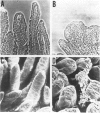Abstract
Neonates of some species of mammals absorb water-soluble macromolecules from the lumen of the gut to the circulation. This is a means for providing the neonate with passive immunological protection. The accepted model for absorption of macromolecules, particularly immunoglobulin G (IgG), has at least three phases: adherence of the macromolecule to the brush border on enterocytes; internalization of the macromolecule within the enterocytes; and egress of the macromolecule into the lamina propria. With regard to the absorption of IgG, adherence is thought to be a specific reaction of ligand (IgG) with a plasmalemma binding site. Pinocytosis is activated and internalization follows. Egress into the lamina propria occurs at the basal-lateral membrane by a process of reverse pinocytosis. Unbound (unprotected) macromolecules that are internalized in the pinocytosic fluid are shunted off to lysosomes and either digested or stored therein. Neonatal rodents fit this model for macromolecular absorption. However, in another group of neonates (e.g., pig, cow, horse), nonselected absorption takes place, in that IgG and other macromolecules are transported from the gut lumen to the blood. In a third group of neonates, (e.g., human, guinea pig) absorption of IgG is either of low order or nonexistent. Since neonatal mammals possess a mechanism for absorbing macromolecules, there is the potential for internalizing toxic macromolecules if the toxin is presented to the neonate's enterocytes in competitive amounts. Adults retain remnants of the neonatal absorptive mechanism.
Full text
PDF



Images in this article
Selected References
These references are in PubMed. This may not be the complete list of references from this article.
- BIERRING F., ANDERSEN H., EGEBERG J., BRO-RASMUSSEN F., MATTHIESSEN M. ON THE NATURE OF THE MECONIUM CORPUSCLES IN HUMAN FOETAL INTESTINAL EPITHELIUM. 1. ELECTRON MICROSCOPIC STUDIES. Acta Pathol Microbiol Scand. 1964;61:365–376. doi: 10.1111/apm.1964.61.3.365. [DOI] [PubMed] [Google Scholar]
- Clarke R. M., Hardy R. N. The use of [125-I] polyvinyl pyrrolidone K. 60 in the quantitative assessment of the uptake of macromolecular substances by the intestine of the young rat. J Physiol. 1969 Sep;204(1):113–125. doi: 10.1113/jphysiol.1969.sp008902. [DOI] [PMC free article] [PubMed] [Google Scholar]
- Jones E. A., Waldmann T. A. The mechanism of intestinal uptake and transcellular transport of IgG in the neonatal rat. J Clin Invest. 1972 Nov;51(11):2916–2927. doi: 10.1172/JCI107116. [DOI] [PMC free article] [PubMed] [Google Scholar]
- Leary H. L., Jr, Lecce J. G. The preferential transport of immunoglobulin G by the small intestine of the neonatal piglet. J Nutr. 1979 Mar;109(3):458–466. doi: 10.1093/jn/109.3.458. [DOI] [PubMed] [Google Scholar]
- Lecce J. G., Broughton C. W. Cessation of uptake of macromolecules by neonatal guinea pig, hamster and rabbit intestinal epithelium (closure) and transport into blood. J Nutr. 1973 May;103(5):744–750. doi: 10.1093/jn/103.5.744. [DOI] [PubMed] [Google Scholar]
- Lecce J. G., King M. W., Mock R. Reovirus-like agent associated with fatal diarrhea in neonatal pigs. Infect Immun. 1976 Sep;14(3):816–825. doi: 10.1128/iai.14.3.816-825.1976. [DOI] [PMC free article] [PubMed] [Google Scholar]
- Lecce J. G., King M. W. Role of rotavirus (reo-like) in weanling diarrhea of pigs. J Clin Microbiol. 1978 Oct;8(4):454–458. doi: 10.1128/jcm.8.4.454-458.1978. [DOI] [PMC free article] [PubMed] [Google Scholar]
- Lecce J. G. Rearing piglets artificially in a farm environment: a promise unfulfilled. J Anim Sci. 1975 Aug;41(2):659–666. doi: 10.2527/jas1975.412659x. [DOI] [PubMed] [Google Scholar]
- Leece J. G. Effect of dietary regimen on cessation of uptake of macromolecules by piglet intestinal epithelium (closure) and transport to the blood. J Nutr. 1973 May;103(5):751–756. doi: 10.1093/jn/103.5.751. [DOI] [PubMed] [Google Scholar]
- Morris B., Morris R. The absorption of 125I-labelled immunoglobulin G by different regions of the gut in young rats. J Physiol. 1974 Sep;241(3):761–770. doi: 10.1113/jphysiol.1974.sp010683. [DOI] [PMC free article] [PubMed] [Google Scholar]
- Ogra S. S., Weintraub D., Ogra P. L. Immunologic aspects of human colostrum and milk. III. Fate and absorption of cellular and soluble components in the gastrointestinal tract of the newborn. J Immunol. 1977 Jul;119(1):245–248. [PubMed] [Google Scholar]
- Rodewald R. Selective antibody transport in the proximal small intestine of the neonatal rat. J Cell Biol. 1970 Jun;45(3):635–640. doi: 10.1083/jcb.45.3.635. [DOI] [PMC free article] [PubMed] [Google Scholar]
- Walker W. A., Isselbacher K. J. Uptake and transport of macromolecules by the intestine. Possible role in clinical disorders. Gastroenterology. 1974 Sep;67(3):531–550. [PubMed] [Google Scholar]




